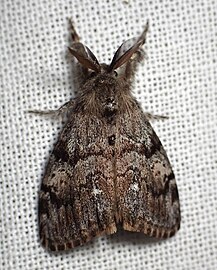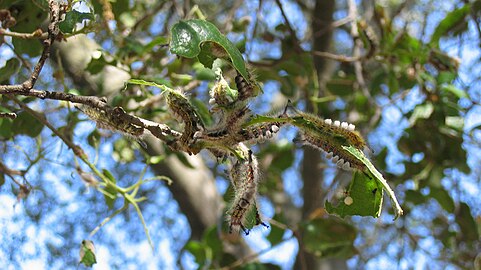Western tussock moth
Species of moth
| Western tussock moth | |
|---|---|
 | |
| Western Tussock Moth caterpillar on madrone or manzanita, San Mateo County, California, 2022 | |
| Scientific classification | |
| Domain: | Eukaryota |
| Kingdom: | Animalia |
| Phylum: | Arthropoda |
| Class: | Insecta |
| Order: | Lepidoptera |
| Superfamily: | Noctuoidea |
| Family: | Erebidae |
| Genus: | Orgyia |
| Species: | O. vetusta |
| Binomial name | |
| Orgyia vetusta Boisduval, 1852 | |
Orgyia vetusta, also known as the western tussock moth, formerly Hemerocampa vetusta, is a moth found in the Pacific States and British Columbia. The species is dimorphic; the females are flightless.
The Western tussock moth is reported on virtually all California oak species as well as various fruit and nut trees, ceanothus, hawthorn, manzanita, pyracantha, toyon, walnut, and willow.[1] There is an isolated population in Boise County, Idaho.[citation needed] This species has also been seen in U.S. gulf coast states such as Louisiana.[citation needed]
Additional images
-
 Moth
Moth -
 Moth
Moth -
 Tussock larva on coast live oak
Tussock larva on coast live oak
References
- ^ Swiecki, Tedmund J.; Bernhardt, Elizabeth A. (2006). A Field Guide to Insects and Diseases of California Oaks. Pacific Southwest Research Station (Report). Gen. Tech Rep. PSW-GTR-197. Albany, California: U.S. Forest Service Treesearch Department. p. 24. doi:10.2737/PSW-GTR-197.
 This article incorporates text from this source, which is in the public domain.
This article incorporates text from this source, which is in the public domain.
- USDA Forest Pest Leaflet 120
- Stanford University Grounds Services: Evaluating the Effectiveness of Releasing Beneficial Insects to Control Tussock Moth Populations at Stanford University
- Note to caterpillars dangling under the oaks: Meet the beetles

Wikimedia Commons has media related to Orgyia vetusta.
- v
- t
- e














